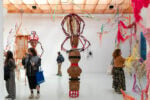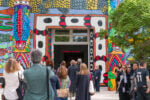Falke Pisano – Constellations of One and Many
.jpg)
Dopo la serie inaugurale Prologue Part One e Part Two, ar/ge kunst Galerie Museum presenta la prima mostra personale italiana dell’artista Falke Pisano in collaborazione con Paolo Caffoni del collettivo editoriale Archive Books.
Comunicato stampa
Constellations of One and Many
Falke Pisano in collaborazione con Archive Books
Inaugurazione Venerdì, 24.01.2014 alle ore 19
24.01. – 22.03.2014
24.01.2014 The man of the crowd
14.02.2014 Here to there, there to here
07.03.2014 Flesh made numbers made flesh again
A cura di Emanuele Guidi
Dopo la serie inaugurale Prologue Part One e Part Two, ar/ge kunst Galerie Museum presenta la prima mostra personale italiana dell’artista Falke Pisano in collaborazione con Paolo Caffoni del collettivo editoriale Archive Books.
La pratica artistica di Falke Pisano si concentra sulla relazione fra poli opposti e complementari quali il linguaggio e il corpo, che caratterizzano le due serie principali di lavori in cui l’artista riflette sulla disgiunzione, la riproducibilità e la ricostruzione rispettivamente dell’atto di parola (Figure of Speech, 2006–2010) e della dimensione corporea (Body in Crisis, 2011–on going).
La ricerca editoriale che Archive Book porta avanti dal 2009 sul tema del “visibile” e sull’immagine cinematica, nelle sue implicazioni socio-politiche, corrisponde a una riflessione sui significati e a una pratica del mettere in mostra e dell’esporsi al pubblico (pubblicare), inteso come momento di azione e trasformazione dei processi produttivi.
Frutto di questa collaborazione fra l'artista e l'editore, il progetto per ar/ge kunst Constellations of One and Many, è un’indagine comune sui rapporti di affezione e potere tra soggetto e collettività che si sviluppa a partire da fonti e casi-studio in letteratura, filosofia e nelle scienze sociali.
L’indagine si riflette direttamente nel display scultoreo concepito da Pisano e Archive Books per la mostra, come formato specifico di presentazione nelle sue coordinate spazio-temporali. Il display ha infatti la funzione di riunire in una costellazione elementi altrimenti dispersi e può essere letto come un diagramma dove il rapporto individuo-collettività, oggetto-architettura trova una sua collocazione aperta e sempre possibile.
Questa apertura si riflette nell’organizzazione temporale del display, che si articola in tre parti distinte lungo il periodo della mostra, nelle quali sia i contenuti che il pubblico sono organizzati (o coreografati) attraverso tre configurazioni differenti e, per definizione, “incomplete”.
La prima configurazione, dal titolo The Man of the Crowd, è un riferimento diretto all’omonimo racconto del 1840 dello scrittore statunitense Edgar Allan Poe. Nel racconto, l’engagement visivo fra i due protagonisti è il termine di relazione per descrivere la folla urbana, colta nel momento storico del suo nascere con la creazione di vaste aree metropolitane e dei nuovi rapporti sociali, produttivi e percettivi che queste mettono in campo.
Il display si sviluppa da queste considerazioni per generare un ipotetico punto di vista individuale all’interno della folla stessa. Un metodo d’indagine che permette di esplorare l'affezione degli individui attraverso il reciproco contatto fisico, la consapevolezza della propria posizione soggettiva e la sua negazione attraverso la perdita di identità nel gruppo.
Nella seconda configurazione Here to There, There to Here [a partire dal 14 febbraio], il punto di vista si sposta per osservare da fuori la rappresentazione di una folla. Negli ultimi anni, a partire dalle cosiddette Primavere arabe e dai movimenti Occupy, assistiamo a una proliferazione – che segue a quella degli anni Sessanta e Settanta – di produzione visiva legata alla rappresentazione della folla. In questo contesto Pisano e Archive Books propongono una serie di domande: Quali sono le implicazioni che la mediatizzazione delle soggettività opera sulle relazioni di prossimità e distanza? Quali sono i modi di attenzione all’immagine di una folla? E in che modo questa immagine entra a far parte di una retorica riconosciuta della rappresentazione del cambiamento sociale?
La terza configurazione Flesh made numbers made flesh again [dal 7 marzo], guarda alla folla come pubblico e ne indaga la produzione di soggettività e la sua rilevanza in termini economici nei modi di produzione post-fordista. Qui l’esposizione è, a partire dalle grandi kermesse internazionali, non solo un dispositivo della visione e del mettere in mostra, ma anche e principalmente una forma di organizzazione della produzione e quindi del sociale.
Falke Pisano (b. 1978, Amsterdam) is an artist based in Berlin. Recent exhibitions include The Body in Crisis, The Showroom, London (2013), Ways of working: the incidental object, Fondazione Merz, Turin (2013), The Body in Crisis (Housing, Treating and Depicting), performance at Museo Reina Sofia, Madrid (2012), and the 9th Shanghai Biennale, Shanghai (2012). In 2013 she won the Prix de Rome, the most important prize for artists under 40 in the Netherlands, which includes a residency at The American Academy in Rome.
Archive Books is a publishing house and editorial collective based in Berlin (current team: Alexandra Bordes, Lilia di Bella, Paolo Caffoni, Chiara Figone, Nicola Guy, Annika Turkovski). Selected publishing titles from 2013/2014 include: Clemens von Wedemeyer, The Cast (edited by Paolo Caffoni); Fight Specific Isola (edited by Isola Art Center); The Psychopathologies of Cognitive Capitalism (edited by Arne de Bover, Warren Neidich). Recent projects and exhibitions have included: Inventory as part of The Books Society, Peephole and Villa Croce, Genoa (2013); How to Tell a Story, Depo, Istanbul (2013); 3rd Thessaloniki Biennale, Thessaloniki (2011). Journals: No Order. Art in a Post-Fordist Society (edited by Marco Scotini); Archive Journal (edited by Archive Books). www.archivebooks.org
Con il gentile sostegno di:
Provincia Autonoma di Bolzano, Ufficio Cultura
Comune di Bolzano, Ufficio Cultura
Fondazione Cassa di Risparmio, Alto Adige
Mondriaan Stichting, Amsterdam
Institut für Auslandsbeziehungen, Stoccarda
Constellations of One and Many
Falke Pisano in collaboration with Archive Books
Opening, Friday 24.01.2014 7 pm
24.01. – 22.03.2014
24.01.2014 The man of the crowd
14.02.2014 Here to there, there to here
07.03.2014 Flesh made numbers made flesh again
Curated by Emanuele Guidi
After its opening series, Prologue part One and part Two, ar/ge kunst presents the first Italian solo exhibition by Falke Pisano in collaboration with Paolo Caffoni from the editorial collective, Archive Books.
Pisano’s artistic practice focuses on the relationship between opposing and complementary poles such as language and body. In these terms, the two principal series of works by the artist (Figure of Speech, 2006–2010, and Body in Crisis, 2011– on-going) are reflections on the disjunction, reproducibility and reconstruction of the act of speech and the corporeal realm.
Archive Books has been developing editorial research on the notions of the ‘visible’ and the cinematic image, with all their socio-political implications, since 2009. This research corresponds to a reflection on both the meanings and the practices of ‘exhibiting’ – of exposing oneself publicly (part of the practice of ‘publishing’ itself); an activity that has to be understood as a moment that enacts and transforms productive processes.
The outcome of this artist–publisher collaboration at ar/ge kunst is a shared investigation entitled Constellations of One and Many. It focuses on the relationships of power and affect that exist between subject and collectivity. It takes its cues from a series of sources and case studies in the fields of literature, philosophy and political science.
This research is directly reflected in the sculptural display that Pisano and Archive Books have conceived for the exhibition: a specific format of presentation with its own spatial and temporal coordinates. The actual function of the display is to bring together otherwise diffuse, disparate elements into an arrangement or constellation. It could also be read as a diagram where the individual–collective, object–architecture relationship finds form that remains open to possibility.
This ‘openness’ is mirrored in the temporal organisation of the display, which is articulated in three distinct parts covering the duration of the exhibition. Both contents and publics are arranged (or choreographed) into three different, and, by definition, incomplete configurations.
The first configuration, titled The Man of the Crowd, is a direct reference to the novel of the same name written in 1840 by American writer Edgar Allan Poe. In this story, the visual engagement between the two main characters is used as a paradigm to describe the urban crowd pictured in the historical moment of its emergence; during the development of extensive metropolitan areas and all the new social, productive and perceptive relationships these entail.
The first display of the exhibition moves from these considerations to actualize a (hypothetical) individual point of view within the crowd itself; a method that serves as way of exploring the affective interpersonal relationships that result from physical contact, the awareness of individual subjectivity and its negation through the loss of identity in the group.
In the second configuration [from 14 February], Here to There, There to Here, the point of view is shifted to observe the image of the crowd from its exterior.
Beginning with the Arab Spring and Occupy Movements, recent years have seen a proliferation of visual imagery representing crowds – a process that follows on from earlier waves for instance in the 1960s and 1970s. Pisano and Archive Books take this observation and derive a set of questions from it: What are the implications of the mediatisation of subjectivities for the relationship of proximity and distance? What modes of attention pertain to the image of a crowd? And what kind of role does this image play in a recognized rhetoric of the representation of social change?
The third configuration [from 7 March], entitled Flesh made numbers made flesh again, focuses on the crowd as public. It investigates the production of the crowd’s subjectivity and its economic relevance to post-Fordist modes of production. In these terms, the exhibition as such – from the great world fairs onwards – was never just a ‘dispositive’ for observing and exposing; it is primarily a means for organising production and, by implication, the social itself.
Falke Pisano (b. 1978, Amsterdam) is an artist based in Berlin. Recent exhibitions include The Body in Crisis, The Showroom, London (2013), Ways of working: the incidental object, Fondazione Merz, Turin (2013), The Body in Crisis (Housing, Treating and Depicting), performance at Museo Reina Sofia, Madrid (2012), and the 9th Shanghai Biennale, Shanghai (2012). In 2013 she won the Prix de Rome, the most important prize for artists under 40 in the Netherlands, which includes a residency at The American Academy in Rome.
Archive Books is a publishing house and editorial collective based in Berlin (current team: Alexandra Bordes, Lilia di Bella, Paolo Caffoni, Chiara Figone, Nicola Guy, Annika Turkovski). Selected publishing titles from 2013/2014 include: Clemens von Wedemeyer, The Cast (edited by Paolo Caffoni); Fight Specific Isola (edited by Isola Art Center); The Psychopathologies of Cognitive Capitalism (edited by Arne de Bover, Warren Neidich). Recent projects and exhibitions have included: Inventory as part of The Books Society, Peephole and Villa Croce, Genoa (2013); How to Tell a Story, Depo, Istanbul (2013); 3rd Thessaloniki Biennale, Thessaloniki (2011). Journals: No Order. Art in a Post-Fordist Society (edited by Marco Scotini); Archive Journal (edited by Archive Books). www.archivebooks.org
With the kind support of:
Provincia Autonoma di Bolzano, Alto Adige, Deutsche Kultur
Fondazione Cassa di Risparmio, Alto Adige
Città di Bolzano, Ufficio Cultura
Mondriaan Stichting, Amsterdam
Institut für Auslandsbeziehungen, Stuttgart



